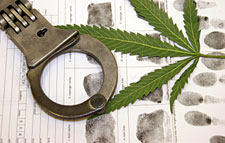The nation’s so-called ‘drug czar’, Gil Kerlikowske, convened a press conference last week to release new government data on drug use in America. The major talking points for the presentation were two fold:
*Insist that cannabis is linked to crime
*The public sentiment in favor of legalization is an unfortunate attraction to ‘bumper sticker solutions’
 One could write a doctoral thesis on Mr.Kerlikowske’s supposition and claims, but suffice for space and time, let’s let the now much more watchdog media on the issue of ending cannabis prohibition better describe what they’ve figured out about ONDCP propaganda, data and the intellectual crime of omission. (Boy, do I have a book recommendation for them…)
One could write a doctoral thesis on Mr.Kerlikowske’s supposition and claims, but suffice for space and time, let’s let the now much more watchdog media on the issue of ending cannabis prohibition better describe what they’ve figured out about ONDCP propaganda, data and the intellectual crime of omission. (Boy, do I have a book recommendation for them…)
Salon reported on the ONDCP’s well established proclivity to throw out data and insinuate causality…using squishy terms like ‘linked’:
On Thursday, Gil Kerlikowske, the director of the Office of National Drug Control Policy, announced the results of a study that—at least according to him—demonstrated a link between marijuana use and crime. The study analyzed data collected via the Arrestee Drug Abuse Monitoring program (ADAM II), which took urine samples from arrestees in five cities over a 21-day period last year. “Marijuana remained the drug most often detected in ADAM II arrestees in all five sites in 2012, ranging from 37 percent of ADAM II arrestees testing positive in Atlanta to 58 percent testing positive in Chicago,” the study reported. “In three of the five sites, over half of the adult male arrestees tested positive for marijuana.”
Kerlikowske, who opposes marijuana legalization, said in a speech Thursday that the study showed that America needs to “acknowledge and come to grips with the link between crime and substance use.” But correlation is not causation. Just because a high percentage of arrestees tested positive for marijuana does not mean that smoking marijuana made them commit crimes. Here are other things that over half of the adult male arrestees probably had in common: pants, food in their stomachs, a mother who loves them, an impoverished background, an affinity for one or more of the local sports teams.
…
Now, Kerlikowske only said that drug use and crime were linked, not that drug use causes crime. But still, the implications are obvious. Kerlikowske is not a stupid man, and he’s not actually a terrible drug czar. He has argued that drug abuse needs to be treated as a public health issue, not just a matter of criminal justice, and I couldn’t agree more. In his speech, Kerlikowske mentioned the need to move the drug policy reform debate beyond “bumper stickers.” One good way to do that is to move beyond studies that don’t necessarily say anything at all.
Reason’s Mike Riggs (a prolific and resourceful blogger about criminal justice matters) took the ONDCP to task one step further by busting the office for omitting alcohol related data and not informing the public more accurately about the most problematic and abused drug for incoming criminal defendants: alcohol
The White House Office of National Drug Control Policy released a study last week that found the majority of arrestees in five metropolitan areas tested positive for marijuana at the time they were booked, and that many other arrestees tested positive for harder drugs. There was one drug missing from the report, however, and it appears it was omitted intentionally. That drug is alcohol.
When I wrote up the 2012 annual report on the Arrestee Drug Abuse Monitoring Program II, I noticed that the methodology section contained a list of “data domains”; basically, a guide to the questions researchers asked each arrestee. Every question listed had a corresponding chart in the findings section of the report, save one: The data that researchers collected about alcohol consumption–how often arrestees had consumed five or more alcoholic drinks in a single session over the last three, seven, and 30 days, as well as in the past 12 months–was omitted from the report.
Article republished from NORML









